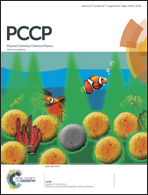1JCH couplings in Group 14/IVA tetramethyls from the gas-phase NMR and DFT structural study: a search for the best computational protocol†
Abstract
Four tetramethyl compounds EMe4 (E = C, Si, Ge, and Pb) were studied by high-resolution NMR spectroscopy in gaseous and liquid states at 300 K. Extrapolation of experimental vapor-phase C–H J-couplings to a zero-pressure limit permitted determining the 1J0,CHs in methyl groups of their nearly isolated molecules. Theoretical predictions of the latter NMR parameters were also performed in a locally dense basis sets/pseudopotential (Sn, Pb) approach, by applying a few DFT methods pre-selected in calculations of other gas-phase molecular properties of all these species and SnMe4 (bond lengths, C–H stretching IR vibrations). A very good agreement theory vs. experiment was achieved with some computational protocols for all five systems. The trends observed in their geometry and associated coupling constants (1JCHs, 2JHHs) are discussed and rationalized in terms of the substituent-induced rehybridization of the methyl group (treated as a ligand) carbon, by using Bent's rule and the newly proposed, theoretically derived values of the Mulliken electronegativity (χ) of related atoms and groups. All these χ data for the Group-14/IVA entities were under a lot of controversy for a very long time. As a result, the recommended χ values are semi-experimentally confirmed for the first time and only a small correction is suggested for χ(Ge) and χ(GeMe3).


 Please wait while we load your content...
Please wait while we load your content...